How The Guitar Amp Tone Stack Work |
The tone stack is one of the most important sections of a guitar amp—it’s where your sound takes shape. Understanding how it works and how to fine-tune it can open the door to a whole new level of control over your playing.
A magnetic guitar pickup naturally acts like a second-order low-pass filter, boosting low-mid frequencies while letting very little high end through. Left uncorrected, this can make your tone sound muddy and muffled. That’s where the amp steps in: the tone stack compensates for this imbalance, restoring clarity, sparkle, and definition to your sound.
To hear the natural sound of a pickup, try setting a typical guitar amp with the middle control at maximum, and the bass and treble all the way down. This setting actually creates a flat response in the amp.
That’s the whole point of these tone controls—they compensate for the natural tonal curve of a pickup. The middle control boosts the pickup’s normal “middley” character, while the treble and bass controls do the opposite: they boost the high and low frequencies, creating a notch in between for a mid cut.
The Fender/Marshall/Vox TMB (Treble-Mid-Bass) tone stack has been around since the 1950s and has become a staple in Fender and Marshall amps. This classic design is still widely used in modern amplifiers.
The TMB stack is essentially a combination of low-pass and high-pass audio filters working together to shape the tone. It’s a relatively low-impedance circuit (high load), so it performs best when driven by a low-impedance source, such as a cathode follower—found in amps like the Fender 5F6A, Marshall JTM45, and many others. That’s why, in many amps, the tone stack is placed directly after a cathode follower.
In the circuit, the input signal splits—part of it passes through the “treble capacitor,” while the rest goes through a resistor into a network of capacitors and potentiometers that form the bass and midrange controls (the midrange pot is sometimes omitted and replaced with a fixed resistor). Everything then comes back together at the treble pot, which acts like a mixer—combining the filtered treble (lows removed by the small-value capacitor) with the bass and midrange signals.
Audio filter reviews
Before we discuss the tone stack circuit which is surprisingly complex due to the interactive nature of its four audio filters, we simple overview simple RC (resistance-capacitance) filter circuits.First, we know: Capacitor can block direct current and let alter current passing through, sodifferent combinations of capacitor and resistor can be comprised of different type filters.
Low pass filter has a resistor first followed by a capacitor connected to ground.It allows low frequencies to pass but high frequencies are blocked.
The cutoff freq of low pass filter is below :
f(cutoff)=1/(2*3.14*R*C)
R---Ohm,C---Farads
Example:
Bass pass filter of TMB of 5F6A is by Rs and CM.Rs is 56k, CM 0.022uf(223). Then the cutoff freq of low pass filter of Rs and CM is 129hz. |
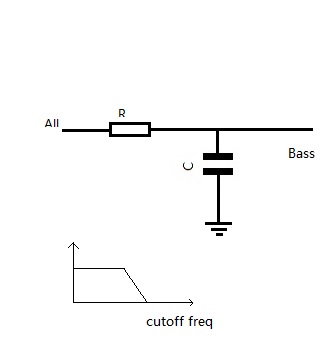
|
|
High pass filter has the capacitor first followed by a resistor connected to ground. A high pass filter allows high frequencies to pass but blocks low frequencies. |
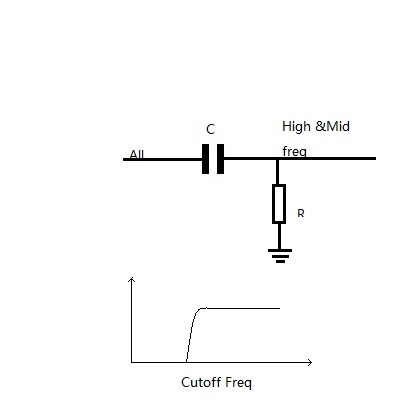 |
|
Tone stack overview |
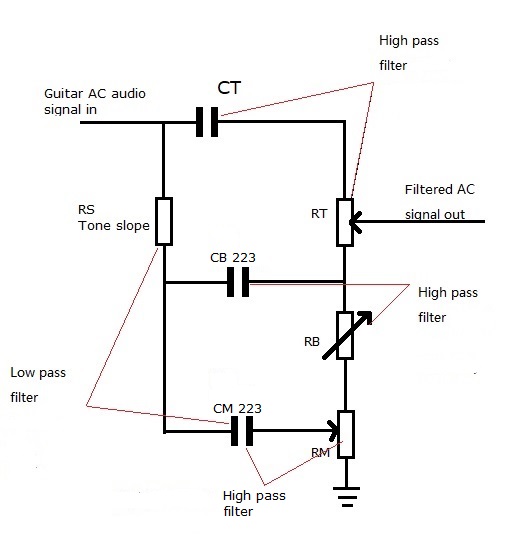
|
Tone stacks of three brand guitar amp
|
RS |
CT |
RT |
CM |
RM |
CB |
RB |
VOX |
100k |
56p |
B250K |
223 |
B20K |
223 |
A1M |
Marshall |
33K |
470p |
B250K |
223 |
B20K |
223 |
A1M |
Fender |
56K |
270p |
B250K |
223 |
B20K |
223 |
A1M |
Tone stack is by one low pass and three high pass filters. The Tone Slope Resistor RS is important part in tone stack,it takes two important roles in tone stack.
Frequency divider:
RS works as a frequency divider with CT(Treble Cap).The high frequencies signal pass around CT and low and mid frequencies passing through RS to the CB (Bass Cap)and CM (Mid Caps).
A larger value Tone Stack resistor will pass fewer bass and mid frequencies so its value changes the balance or "slope" of the tone stack's frequency response.
The treble high pass filter made up of the CT(Treble Cap)+ RT(Treble Pot) blocks frequencies below approximately 2359Hz to 2184HZ(Fender), allow higher frequencies to pass.The high frequencies are sent to the top terminal of the RT. The bass and mid frequencies signals that pass through the bass and mid filters flow to the RT's lower terminal so the RT is a balance control that allows you to select between the high and low frequencies at its outside terminals.
Low pass filter:
RS + CM (Mid Cap )form the only low pass filter of tone stack filtering high frequency signal and work with two high pass filters (CB+RB,CM+RM). These circuits constitute two band pass filters removing frequencies above and below the desired band of frequencies.The freq range of these band filters are controlled by RB(Bass control)and RM(Mid control). The cutoff freqs of low pass filter in different amps below:
| |
RS+CM low pass filter cutoff freq |
| VOX |
72HZ |
| Marshall |
219HZ |
| Fender |
129HZ |
One end of CM is connected with RM, this is difference with general low pass filter that the capacitor is connected with ground.The mid & high freq signals from band filters go to one end of the RT through RM, mixing with high freq signal from high pass filter.
The cutoff frequency of high pass filter controlled by RB varies between 7.2Hz and 361Hz. With the RB full up the bass high pass filter only blocks frequencies below 7.2Hz so all guitar and bass frequencies get through. With the RB full down the filter blocks frequencies below 361Hz so most of the bass is filtered out.
The cutoff frequency of high pass filter controlled by RM varies between 361Hz to infinitely high. With the RM full up the mid high pass filter only blocks frequencies below 361Hz.With the RM full down the mid filter blocks all frequencies.
Freq flow in tone stack below.
|
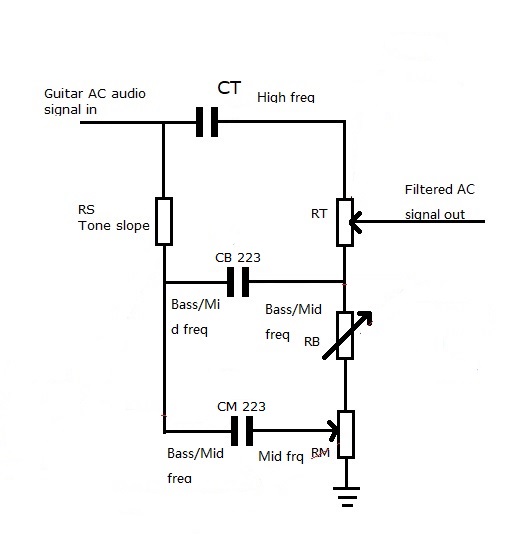 |
|
RM works in tone stack
|
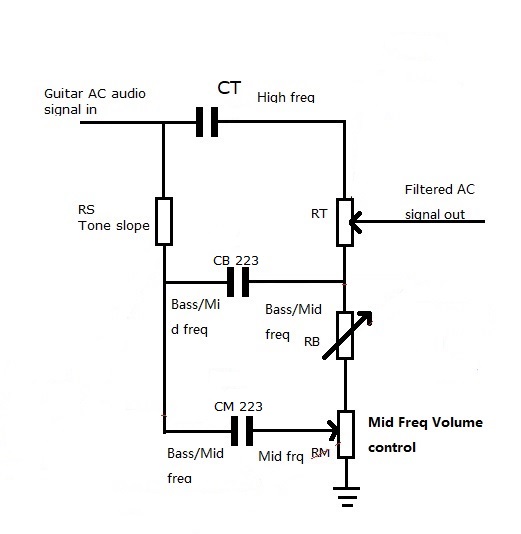 |
|
The combination of the low pass filter which formed by RS+CM and high pass filters which formed by CM+ RM creates a band pass filter. So only mid freqs signals pass through.
The RM control this band pass filter that functions like a mid frequency volume control. At higher RM, this band filter acts as a simple high pass filter which blocks low freq signals but allows mid freq signals through. As RM is turn down , the mid filter's cutoff frequency increases.The cutoff frequency runs from 361Hz with the RM max, to infinitely high with the RM zero.
A high pass filter with an infinitely high cutoff frequency blocks all frequencies so no audio will pass.
The RM below the wiper comes after the low pass filter, which let some mid and high freq signals pass through the filter. Only turning the RM to zero, the RS + CM low pass filter could cut off all frequencies above cutoff, let bass freq signals pass to the RT.
RB works in tone stack |
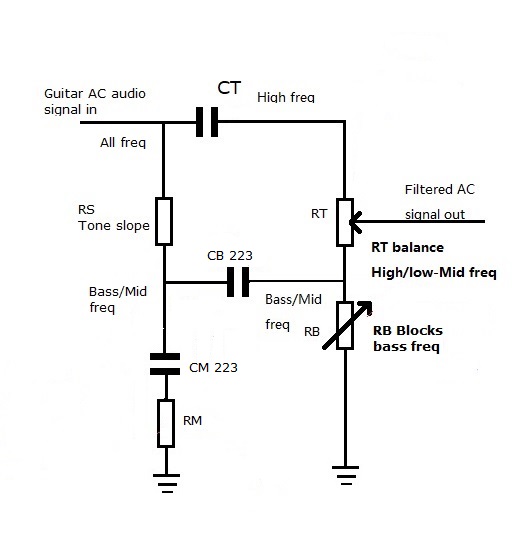 |
RS+ CM form low pass filter, The bass and mid freq signals pass on to the CB. CB + (RB+ RM) form high pass filter, the RB blocks low frequencies.
By filtering the guitar audio through a low pass filter followed by a high pass filter (Bass control) a variable band pass filter is created that only affects bass freq signals.
With the bass high pass filter's resistance of RB1M + RM 20K = 1.020M with the RB max gives a cutoff frequency of 7.2Hz.
With the bass high pass filter's resistance of 0 RB +RM 20K = 20K with the RB minimum gives a cutoff frequency of 361Hz. Note the mid filter's lowest cutoff frequency is 361Hz so the bass and mid filters match up perfectly.
The RM below the wiper comes after the low pass filter let some mid and high freq signals pass through the filter to the CB. The RB has no effect when the RM and RT are full down
RT works in tone stack
|
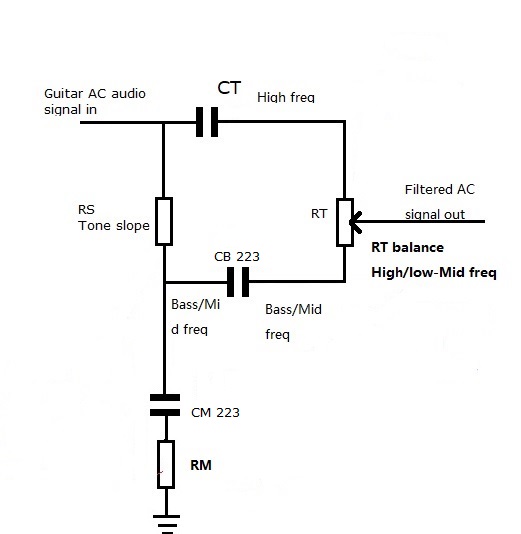 |
CT + (RT+ RM ) form high pass filter, the high freq signals pass across the top of the tone stack.RS +CM form low pass filter, the bass and mid freq signal flow through the RS and CB around to the RT.
Turning the RT does not change the CT+ RT high pass filter cutoff frequency because the RT full 250k of resistance is always in the filter's path to ground--moving the RT wiper does not change this.Turning the RT adjusts the balance between high frequencies on the top side of the RT and Bass & Mid frequencies on the bottom side of the pot.
The RM is added to the treble high pass filter's resistance. The treble high pass filter's resistance ranges from RT with the RM set to minimum to RT+RM with the RM set to Max.The CT + RT high pass filter blocks frequencies below:
| |
Cutoff freq of( CT+RT+RM)RM max |
Cutoff freq of (CT+RT+RM)RM min |
| VOX |
10531(HZ) |
11373(HZ) |
| Marshall |
1355(HZ) |
1254(HZ) |
| Fender |
2184(HZ) |
2359(HZ) |
The RB setting has no effect on the treble high pass filter cutoff frequency because the treble filter's path to ground can flow through the CB and CM to flow around the Bass Pot.
The RS got its name because its resistance affects the balance between high frequencies that flow across the top of the tone stack and bass & mid frequencies that flow below through the rest of the tone stack. A smaller RS will tilt the frequency balance toward bass frequencies by reducing treble and increasing bass. A larger resistor will tilt it toward high freqs and less bass. A larger RS will also reduce the Tone Stack's load (raise its impedance). That's one of the reasons the Fender blackface amps use a 100k Tone Slope resistor.
Conclusion
| |
Low-Freq response(HZ) |
High-Freq response(HZ) |
| VOX |
30 |
11373 |
| Marshall |
68 |
1355 |
| Fender |
47 |
2359 |
With the bass and treble controls at minimum, the midrange control determines the overall attenuation for all guitar frequencies. When the bass control setting is increased, it allows bass to bleed back into the mix, reducing the attenuation for its passband.
The Marshall midrange control offers more midrange at the top end of the control setting, but a more accelerated gain variation depending on the setting. The 5F6-A, on the other hand, has less maximum midrange, but finer midrange control. |